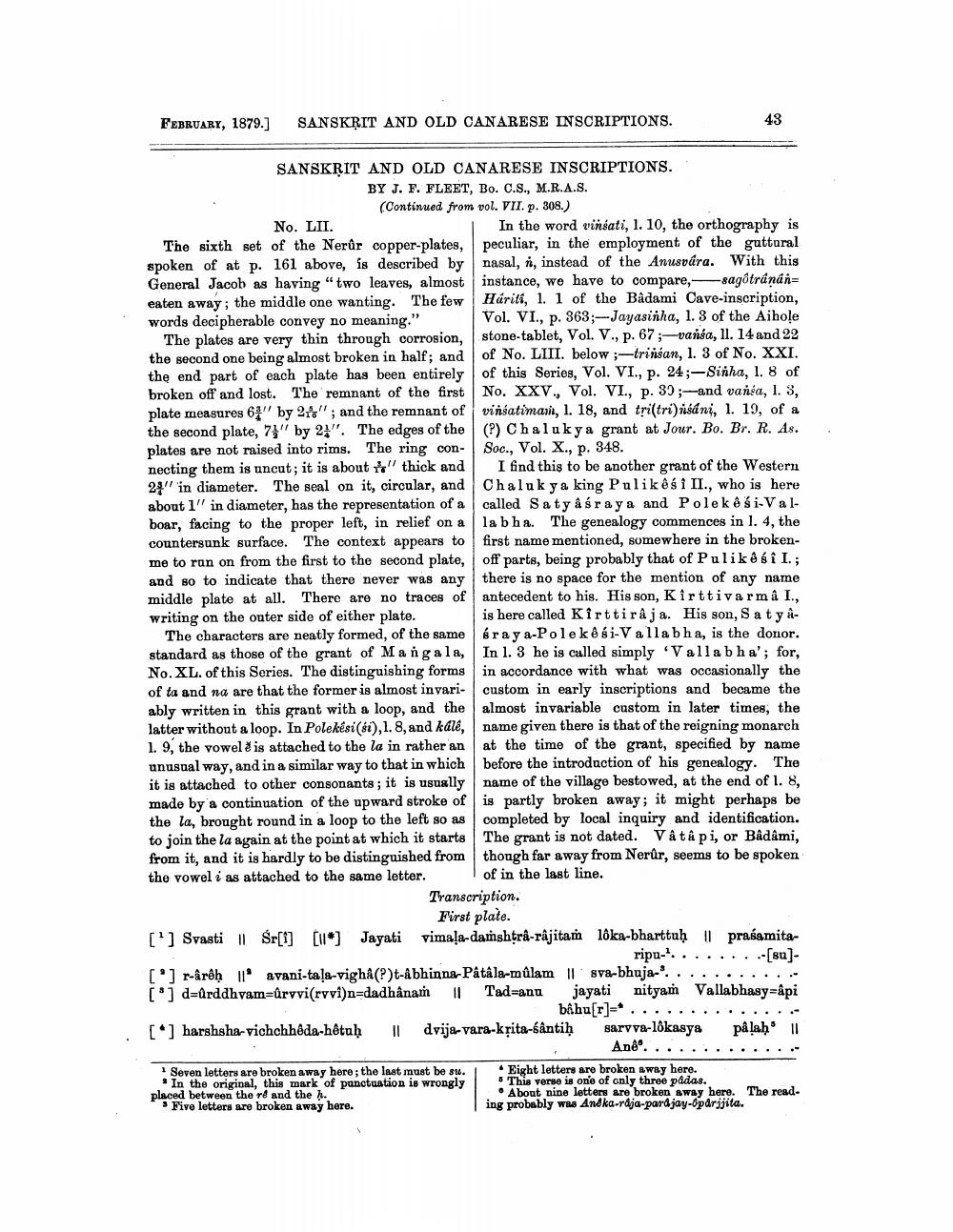________________
FEBRUARY, 1879.]
SANSKRIT AND OLD CANARESE INSCRIPTIONS.
SANSKRIT AND OLD CANARESE INSCRIPTIONS.
BY J. F. FLEET, Bo. C.S., M.R.A.S.
(Continued from vol. VII. p. 308.) No. LII.
1 In the word vinsati, 1. 10, the orthography is The sixth set of the Nerûr copper-plates, peculiar, in the employment of the guttural spoken of at p. 161 above, is described by nasal, n, instead of the Anusvára. With this General Jacob as having "two leaves, almost instance, we have to compare, sagôtránán= eaten away; the middle one wanting. The few Hárill, 1. 1 of the Badami Cave-inscription, words decipherable convey no meaning." Vol. VI., p. 363;-Jayasinha, 1. 3 of the Aihole
The plates are very thin through corrosion, stone-tablet, Vol. V., p. 67;-vanía, II. 14 and 22 the second one being almost broken in half; and of No. LIII. below ;-trinsan, 1. 3 of No. XXI. the end part of each plate has been entirely of this Series, Vol. VI., p. 24;-Sinha, 1. 8 of broken off and lost. The remnant of the first No. XXV., Vol. VI., p. 39;--and vanéa, 1. 3, plate measures 61 by 21%''; and the remnant of vinsatimai, 1. 18, and tri(tri) nisani, 1. 19, of a the second plate, 7}" by 2". The edges of the (?) Chalukya grant at Jour. Bo. Br. R. As. plates are not raised into rims. The ring con- Soc., Vol. X., p. 348. necting them is uncut; it is about " thick and I find this to be another grant of the Western 21 in diameter. The seal on it, circular, and Chalu k y a king Pulik és i II., who is here about 1" in diameter, has the representation of a called Satyaśraya and Polek ési-Valboar, facing to the proper left, in relief on a labha. The genealogy commences in l. 4, the countergunk surface. The context appears to first name mentioned, somewhere in the brokenme to run on from the first to the second plate, off parts, being probably that of Pulikasi I.; and so to indicate that there never was any there is no space for the mention of any name middle plate at all. There are no traces of antecedent to his. His son, Kirttivarma I., writing on the outer side of either plate. is here called Kirttiraja. His son, Satya
The characters are neatly formed, of the same éra y a-Polek ési-Vallabha, is the donor. standard as those of the grant of Mangala, In 1. 3 he is called simply Vallabh a'; for, No. XL. of this series. The distinguishing forms in accordance with what was occasionally the of ta and na are that the former is almost invari- custom in early inscriptions and became the ably written in this grant with a loop, and the almost invariable custom in later times, the latter without a loop. In Polekési(si), 1.8, and kálé, name given there is that of the reigning monarch 1. 9, the voweld is attached to the la in rather an at the time of the grant, specified by name unusual way, and in a similar way to that in which before the introduction of his genealogy. The it is attached to other consonants; it is usually name of the village bestowed, at the end of 1. 8, made by a continuation of the upward stroke of is partly broken away; it might perhaps be the la, brought round in a loop to the left so as completed by local inquiry and identification. to join the la again at the point at which it starts The grant is not dated. Vâtâpi, or Bâdami, from it, and it is hardly to be distinguished from though far away from Nerur, seems to be spoken the vowel i as attached to the same letter of in the last line.
Transcription.
First plate. ['] Svasti | Sr[i] [119] Jayati vimala-damshtrå-rajitam lôka-bharttuh || prasamita
ripu-.......--[su]lr-frøh a vani-tala-vighA()t-Abhinna-Pâtâla-mulam l sva-bhuja-...........[°] darddhvam=ûrvvi(rvvi)n=dadhanam 1 Tad=anu jayati nityam Vallabhasy=&pi
bâhu[r]-* .............. [ ] harshsha-vichchhôda-hêtuḥ dvija-vara-krita-sântiḥ sarvva-lokasya pâlah
Anê.............Seven letters are broken away here; the last must be su. Eight letters are broken away here. . In the original, this mark of punctuation is wrongly
• This verse is one of only three padas. placed between the re and the h.
• About nine letters are broken away here. The read. Five letters are broken away here.
ing probably was Antka-raja-pardjay-Opárjjita.




